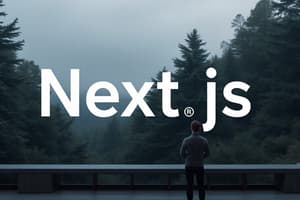Podcast
Questions and Answers
What is the purpose of the dropdown menu at the top of the sidebar?
What is the purpose of the dropdown menu at the top of the sidebar?
- To select either the App Router or the Pages Router features (correct)
- To switch between different versions of Next.js
- To navigate between sections of a page
- To search for specific pages
Why is it important to keep track of which tab is selected in the sidebar?
Why is it important to keep track of which tab is selected in the sidebar?
- To be aware of the specific features available in the selected router (correct)
- To find a specific page quickly
- To navigate between different versions of Next.js
- To determine if the docs are beginner-friendly
Which feature does the App Router support that the Pages Router does not?
Which feature does the App Router support that the Pages Router does not?
- Server Components (correct)
- Building older Next.js applications
- Streaming
- Server-rendered React applications
What is the purpose of the breadcrumbs at the top of the page in the Next.js docs?
What is the purpose of the breadcrumbs at the top of the page in the Next.js docs?
Which router allowed building server-rendered React applications and continues to be supported for older Next.js applications?
Which router allowed building server-rendered React applications and continues to be supported for older Next.js applications?
Why is it recommended to have a basic understanding of HTML, CSS, and React before using the Next.js documentation?
Why is it recommended to have a basic understanding of HTML, CSS, and React before using the Next.js documentation?
What is the main purpose of using Next.js in a React application?
What is the main purpose of using Next.js in a React application?
What type of rendering is supported by Next.js?
What type of rendering is supported by Next.js?
Which feature of Next.js supports file-system based routing, layouts, nested routing, loading states, and error handling?
Which feature of Next.js supports file-system based routing, layouts, nested routing, loading states, and error handling?
What does Next.js provide to simplify data fetching in Server Components?
What does Next.js provide to simplify data fetching in Server Components?
asdasd
asdasd
asdasd
asdasd
Flashcards are hidden until you start studying
Study Notes
Sidebar Dropdown Menu
- Dropdown menu in the sidebar allows users to navigate between different sections or tabs of the interface efficiently.
- Important for enhancing user experience by making it easier to switch contexts without losing track of current activities.
Tab Selection Tracking
- Keeping track of the selected tab ensures that users are aware of their current location within the interface, preventing confusion.
- Essential for maintaining a fluid workflow and seamless navigation through various features.
App Router vs. Pages Router
- App Router supports features such as enhanced data fetching and improved routing capabilities that are not available in the Pages Router.
- App Router facilitates more advanced navigation patterns, making it more suitable for dynamic applications.
Breadcrumbs Purpose
- Breadcrumbs at the top of the page help users understand their location within the documentation hierarchy.
- They provide context and allow quick navigation back to previous sections without losing track of the path taken.
Supported Router for Older Applications
- The Pages Router is designed to support the building of server-rendered React applications and continues to be maintained for legacy Next.js projects.
- It provides foundational capabilities that are still applicable in existing applications.
Importance of Basic Knowledge
- A basic understanding of HTML, CSS, and React is recommended to effectively utilize Next.js documentation.
- Familiarity with these technologies ensures users can comprehend examples and implement features correctly within their applications.
Purpose of Using Next.js
- Next.js primarily aims to enhance React applications by providing server-side rendering, static site generation, and optimized performance.
- It focuses on improving SEO and loading times by pre-rendering pages.
Rendering Types Supported
- Next.js supports multiple types of rendering, including server-side rendering (SSR), static site generation (SSG), and client-side rendering (CSR).
- This flexibility allows developers to choose the best rendering strategy for their specific use case.
File-System Based Features
- Next.js includes features supporting file-system based routing, which enables easy setup of routes through the project's folder structure.
- It encompasses layouts, nested routing, loading states, and integrated error handling capabilities for better application structure.
Data Fetching Simplification
- Next.js simplifies data fetching in Server Components by providing built-in functionalities that streamline the process of retrieving and managing data.
- Enhances the developer experience by reducing boilerplate code and improving data handling efficiency.
Studying That Suits You
Use AI to generate personalized quizzes and flashcards to suit your learning preferences.




